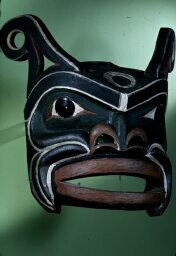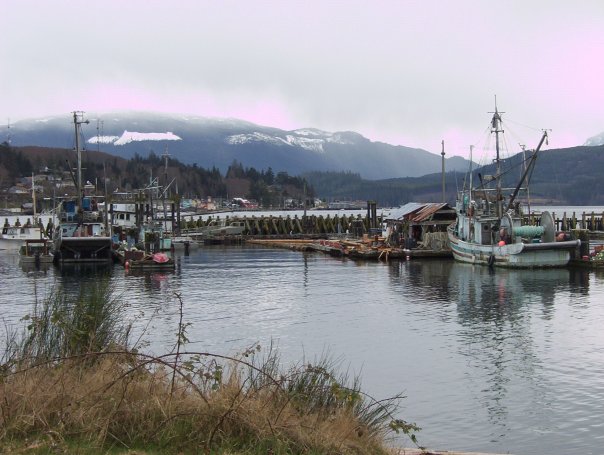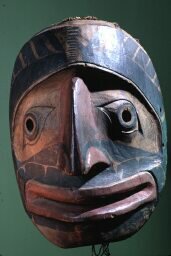 For the indigenous First Nations of Canada’s Pacific coast, masks are more than mere decoration or ceremonial props; they are part of a living tradition that connects people to their community, their collective past, their creator, their ancestors, their cosmology, and powerful elemental forces.
For the indigenous First Nations of Canada’s Pacific coast, masks are more than mere decoration or ceremonial props; they are part of a living tradition that connects people to their community, their collective past, their creator, their ancestors, their cosmology, and powerful elemental forces.
The majority of the masks presented here were made by Kwakiutl[1] (now known as Kwakwaka’wakw) carvers and were collected by Samuel A. Barrett in 1915. These masks permit us a glimpse into the diverse array of characters and ideas that still constitute the heart of Kwakiutl social, religious, and political life. What is more, these masks also afford us a chance to reflect on the era (1880-1920) of museum and private collecting, a period of considerable political struggle and hardship for Kwakiutl and other First Nations, but recognized as a “gilded age” for wealthy American and European collectors and the general public that often benefited from their philanthropy.
The Milwaukee Public Museum's (MPM) collection of Kwakiutl masks is among the finest of its kind in the world, containing many pieces the likes of which cannot be found elsewhere. Barrett, the Museum’s first curator of Anthropology and a student of renowned anthropologist Franz Boas, acquired most of these pieces at Fort Rupert and Alert Bay, both located on the north end of Vancouver Island (Mochon 1966: 17-22; Cole 1985: 247, 248; Gentilli 1999: 2-3). These communities were the largest Kwakiutl villages at the time that Barrett was collecting, even though neither was originally a Kwakiutl settlement but likely emerged in order to facilitate trade with European settlers (Jacknis 1991:177). The period in which Barrett conducted his expedition into British Columbia has been described by Douglas Cole as a “scramble” for Northwest Coast Art (Cole 1985), as museums, missionaries, private collectors, and others competed to acquire the best and highest quality pieces, and Barrett himself notes that he was able to rapidly acquire a great number of masks and other objects during his foray into the region (Mochon 1966:17; Jacknis 1991: 202).

Alert bay, British Columbia, Canada (2008)
(Photo courtesy of Joel Zovar)
There are several reasons why anthropologists collected ethnographic pieces from the West Coast at this time, not the least of which was because it was erroneously held that by studying native peoples of North America scientists could learn how Europeans’ ancestors lived in a more “primitive” past (Patterson 2001: 78). Related to this, many social scientists feared that Indians were “vanishing” as a consequence of the colonial legacy of genocide, Christian evangelization, and legislation that sought to displace indigenous traditions and assimilate native peoples into settler society. Many anthropologists in this era thus engaged in a form of salvage ethnography, seeking to acquire as many goods and as much information as possible before Indians became “extinct” (Cole 1985: 13; Deloria 1999: 80).

Nutamat (fool dancer) mask
Samuel Barrett stated that his reason for collecting was to accumulate a representative sample of Kwakiutl cultural arts (Cole 1985: 247) and he was successful largely due to two factors: Christian evangelization and the Potlatch ban. Conversion to Christianity spurred many people to forfeit their ceremonial goods, and when these goods were not outright destroyed, they were often sold to eager collectors. Similarly, the Potlatch ban forced many Kwakiutl still retaining ceremonial Potlatch regalia to sell their masks and other goods to avoid being caught in possession of contraband (for more on the Potlatch, see the section entitled “Kwakiutl Ceremonial Life”). Impoverishment also forced many Kwakiutl to sell their possessions, for while legislation such as the Indian Act (1876) was intended to integrate First Nations into the state, Kwakiutl social structure and local economies had been decimated by a surge of farmers, traders and missionaries, while racism (political, popular, scientific, and economic) was rampant (Gentilli 1999:2).
Few Kwakiutl would have been able to find equitable work within settler society and still openly maintain their beliefs and traditions, even though economic opportunities for native peoples in the Northwest were more widely available than in most other parts of Canada or the U.S. (Wyatt 1984:17; Cole 1991: 136). At the same time, the Indian Act forbade the sale of certain materials on reserve land, allowed for non-natives to lease reserve land if it were to be used for agricultural development, and ended the legal inheritance of hereditary tribal lands (Cole 1985: 276; Indian and Northern Affairs Canada 2006). This situation was problematic for two reasons. First, the few legal entitlements and benefits that indigenous status evoked would have been jeopardized by moving off reserves to find employment or farm. Second, popular perceptions of authentic “Indianness” were defined at the time solely in opposition to White society and in conformity with popular stereotypes, making integration into Canadian settler society difficult for native peoples who wanted to be full citizens of the Canadian government and still retain their indigenous identity (Raibmon 2005).
1. Anthropologists have popularized the term Kwakiutl to refer to all Kwakwala speaking peoples of British Columbia. Though contemporary Kwakwala speaking First Nations generally refer to themselves as Kwakwaka’wakw, the term Kwakiutl will be used here for the sake of literary continuity and simplification.
Kwakiutl mask webpage developed by Joel Zovar, University of Illinois Urbana-Champaign graduate student, 2010.
Questions? Contact Dawn Scher Thomae

